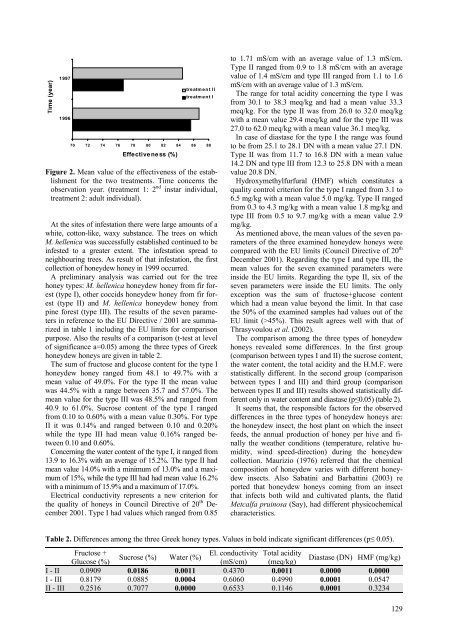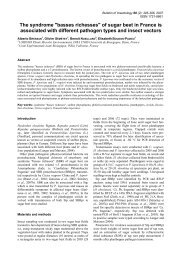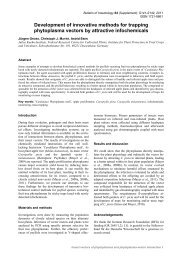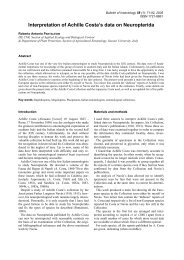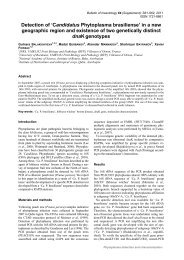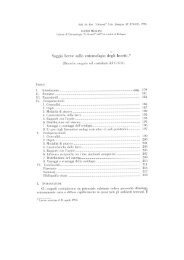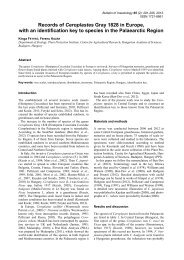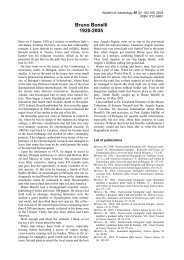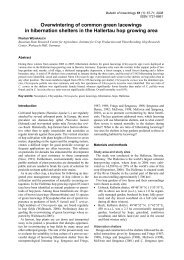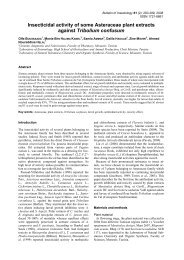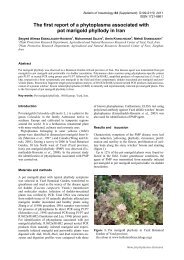on fir tree (Abies cephalonica) - Bulletin of insectology
on fir tree (Abies cephalonica) - Bulletin of insectology
on fir tree (Abies cephalonica) - Bulletin of insectology
Create successful ePaper yourself
Turn your PDF publications into a flip-book with our unique Google optimized e-Paper software.
Time (year)<br />
1997<br />
1996<br />
70 72 74 76 78 80 82 84 86 88<br />
Effectiveness (%)<br />
treatment II<br />
treatment I<br />
Figure 2. Mean value <strong>of</strong> the effectiveness <strong>of</strong> the establishment<br />
for the two treatments. Time c<strong>on</strong>cerns the<br />
observati<strong>on</strong> year. (treatment 1: 2 nd instar individual,<br />
treatment 2: adult individual).<br />
At the sites <strong>of</strong> infestati<strong>on</strong> there were large amounts <strong>of</strong> a<br />
white, cott<strong>on</strong>-like, waxy substance. The <strong>tree</strong>s <strong>on</strong> which<br />
M. hellenica was successfully established c<strong>on</strong>tinued to be<br />
infested to a greater extent. The infestati<strong>on</strong> spread to<br />
neighbouring <strong>tree</strong>s. As result <strong>of</strong> that infestati<strong>on</strong>, the <strong>fir</strong>st<br />
collecti<strong>on</strong> <strong>of</strong> h<strong>on</strong>eydew h<strong>on</strong>ey in 1999 occurred.<br />
A preliminary analysis was carried out for the <strong>tree</strong><br />
h<strong>on</strong>ey types: M. hellenica h<strong>on</strong>eydew h<strong>on</strong>ey from <strong>fir</strong> forest<br />
(type I), other coccids h<strong>on</strong>eydew h<strong>on</strong>ey from <strong>fir</strong> forest<br />
(type II) and M. hellenica h<strong>on</strong>eydew h<strong>on</strong>ey from<br />
pine forest (type III). The results <strong>of</strong> the seven parameters<br />
in reference to the EU Directive / 2001 are summarized<br />
in table 1 including the EU limits for comparis<strong>on</strong><br />
purpose. Also the results <strong>of</strong> a comparis<strong>on</strong> (t-test at level<br />
<strong>of</strong> significance a=0.05) am<strong>on</strong>g the three types <strong>of</strong> Greek<br />
h<strong>on</strong>eydew h<strong>on</strong>eys are given in table 2.<br />
The sum <strong>of</strong> fructose and glucose c<strong>on</strong>tent for the type I<br />
h<strong>on</strong>eydew h<strong>on</strong>ey ranged from 48.1 to 49.7% with a<br />
mean value <strong>of</strong> 49.0%. For the type II the mean value<br />
was 44.5% with a range between 35.7 and 57.0%. The<br />
mean value for the type III was 48.5% and ranged from<br />
40.9 to 61.0%. Sucrose c<strong>on</strong>tent <strong>of</strong> the type I ranged<br />
from 0.10 to 0.60% with a mean value 0.30%. For type<br />
II it was 0.14% and ranged between 0.10 and 0.20%<br />
while the type III had mean value 0.16% ranged between<br />
0.10 and 0.60%.<br />
C<strong>on</strong>cerning the water c<strong>on</strong>tent <strong>of</strong> the type I, it ranged from<br />
13.9 to 16.3% with an average <strong>of</strong> 15.2%. The type II had<br />
mean value 14.0% with a minimum <strong>of</strong> 13.0% and a maximum<br />
<strong>of</strong> 15%, while the type III had had mean value 16.2%<br />
with a minimum <strong>of</strong> 15.9% and a maximum <strong>of</strong> 17.0%.<br />
Electrical c<strong>on</strong>ductivity represents a new criteri<strong>on</strong> for<br />
the quality <strong>of</strong> h<strong>on</strong>eys in Council Directive <strong>of</strong> 20 th December<br />
2001. Type I had values which ranged from 0.85<br />
XXXXXXXXXXXXXXXXXXXXXXXXXXXxxxxx<br />
to 1.71 mS/cm with an average value <strong>of</strong> 1.3 mS/cm.<br />
Type II ranged from 0.9 to 1.8 mS/cm with an average<br />
value <strong>of</strong> 1.4 mS/cm and type III ranged from 1.1 to 1.6<br />
mS/cm with an average value <strong>of</strong> 1.3 mS/cm.<br />
The range for total acidity c<strong>on</strong>cerning the type I was<br />
from 30.1 to 38.3 meq/kg and had a mean value 33.3<br />
meq/kg. For the type II was from 26.0 to 32.0 meq/kg<br />
with a mean value 29.4 meq/kg and for the type III was<br />
27.0 to 62.0 meq/kg with a mean value 36.1 meq/kg.<br />
In case <strong>of</strong> diastase for the type I the range was found<br />
to be from 25.1 to 28.1 DN with a mean value 27.1 DN.<br />
Type II was from 11.7 to 16.8 DN with a mean value<br />
14.2 DN and type III from 12.3 to 25.8 DN with a mean<br />
value 20.8 DN.<br />
Hydroxymethylfurfural (HMF) which c<strong>on</strong>stitutes a<br />
quality c<strong>on</strong>trol criteri<strong>on</strong> for the type I ranged from 3.1 to<br />
6.5 mg/kg with a mean value 5.0 mg/kg. Type II ranged<br />
from 0.3 to 4.3 mg/kg with a mean value 1.8 mg/kg and<br />
type III from 0.5 to 9.7 mg/kg with a mean value 2.9<br />
mg/kg.<br />
As menti<strong>on</strong>ed above, the mean values <strong>of</strong> the seven parameters<br />
<strong>of</strong> the three examined h<strong>on</strong>eydew h<strong>on</strong>eys were<br />
compared with the EU limits (Council Directive <strong>of</strong> 20 th<br />
December 2001). Regarding the type I and type III, the<br />
mean values for the seven examined parameters were<br />
inside the EU limits. Regarding the type II, six <strong>of</strong> the<br />
seven parameters were inside the EU limits. The <strong>on</strong>ly<br />
excepti<strong>on</strong> was the sum <strong>of</strong> fructose+glucose c<strong>on</strong>tent<br />
which had a mean value bey<strong>on</strong>d the limit. In that case<br />
the 50% <strong>of</strong> the examined samples had values out <strong>of</strong> the<br />
EU limit (>45%). This result agrees well with that <strong>of</strong><br />
Thrasyvoulou et al. (2002).<br />
The comparis<strong>on</strong> am<strong>on</strong>g the three types <strong>of</strong> h<strong>on</strong>eydew<br />
h<strong>on</strong>eys revealed some differences. In the <strong>fir</strong>st group<br />
(comparis<strong>on</strong> between types I and II) the sucrose c<strong>on</strong>tent,<br />
the water c<strong>on</strong>tent, the total acidity and the H.M.F. were<br />
statistically different. In the sec<strong>on</strong>d group (comparis<strong>on</strong><br />
between types I and III) and third group (comparis<strong>on</strong><br />
between types II and III) results showed statistically different<br />
<strong>on</strong>ly in water c<strong>on</strong>tent and diastase (p≤0.05) (table 2).<br />
It seems that, the resp<strong>on</strong>sible factors for the observed<br />
differences in the three types <strong>of</strong> h<strong>on</strong>eydew h<strong>on</strong>eys are:<br />
the h<strong>on</strong>eydew insect, the host plant <strong>on</strong> which the insect<br />
feeds, the annual producti<strong>on</strong> <strong>of</strong> h<strong>on</strong>ey per hive and finally<br />
the weather c<strong>on</strong>diti<strong>on</strong>s (temperature, relative humidity,<br />
wind speed-directi<strong>on</strong>) during the h<strong>on</strong>eydew<br />
collecti<strong>on</strong>. Maurizio (1976) referred that the chemical<br />
compositi<strong>on</strong> <strong>of</strong> h<strong>on</strong>eydew varies with different h<strong>on</strong>eydew<br />
insects. Also Sabatini and Barbattini (2003) re<br />
ported that h<strong>on</strong>eydew h<strong>on</strong>eys coming from an insect<br />
that infects both wild and cultivated plants, the flatid<br />
Metcalfa pruinosa (Say), had different physicochemical<br />
characteristics.<br />
Table 2. Differences am<strong>on</strong>g the three Greek h<strong>on</strong>ey types. Values in bold indicate significant differences (p≤ 0.05).<br />
Fructose +<br />
El. c<strong>on</strong>ductivity Total acidity<br />
Sucrose (%) Water (%)<br />
Glucose (%)<br />
(mS/cm) (meq/kg)<br />
Diastase (DN) HMF (mg/kg)<br />
I - II 0.0909 0.0186 0.0011 0.4370 0.0011 0.0000 0.0000<br />
I - III 0.8179 0.0885 0.0004 0.6060 0.4990 0.0001 0.0547<br />
II - III 0.2516 0.7077 0.0000 0.6533 0.1146 0.0001 0.3234<br />
129


